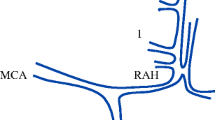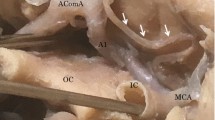Summary
The anterior communicating artery (ACoA) and its branches were examined in 22 human brains after injecting Indian ink or methylmethacrylate. The ACoA branches were divided into the small and the large. Small branches were from 1 to 5 in number (mean 2), and from 70 to 270 Μm in diameter (mean 151 Μm). Seventy-six percent of the branches originated directly from the ACoA. They tended to arise closer to the left than to the right anterior cerebral artery. Fourteen percent of them arose from the junctional site of the ACoA with the anterior cerebral arteries, and 10% from the site of origin of the subcallosal artery. Large branches were identified as the median artery of the corpus callosum, and the subcallosal artery, respectively. The former vessel was present in 9% of the patients, and the latter in 91%. The subcallosal artery was from 320 to 640 urn in size (mean 486 Μm). It tended to arise from the middle of the ACoA.
In spite of the very frequent anastomoses involving the ACoA branches, care must be taken to avoid injury to these important vessels during operations of the ACoA aneurysms.
Similar content being viewed by others
References
Alexander MP, Freedman M (1984) Amnesia after anterior communicating artery aneurysm rupture. Neurology 34: 752–755
Baptista AG (1963) Studies on the arteries of the brain. II The anterior cerebral artery. Some anatomic features and their clinical implications. Neurology 13: 825–835
Choudhury AR (1976) Proximal occlusion of the dominant anterior cerebral artery for anterior communicating aneurysm. J Neurosurg 45: 484–490
Crowell RM, Morawetz RB (1977) The anterior communicating artery has significant branches. Stroke 8: 272–273
Dandy WE (1969) Intracranial arterial aneurysms. Hafner Publishing Company, New York London, pp 44–50
Dunker RO, Harris BA (1976) Surgical anatomy of the proximal anterior cerebral artery. J Neurosurg 44: 359–367
Fox RH, Daview TW, Marsh PPet al (1970) Hypothermia in a young man with an anterior hypothalamic lesion. Lancet 25: 185–188
Gade A (1982) Amnesia after operations on aneurysms of the anterior communicating artery. Surg Neurol 18: 46–49
Gomes FB, Dujovny M, Umansky Fet al (1986) Microanatomy of the anterior cerebral artery. Surg Neurol 26: 129–141
Hamby WB (1969) Intracranial surgery for aneurysms. In: Krayenbühl Het al (eds) Progress in neurological surgery, Vol 3, S. Karger, Basel New York, pp 1–65
Hockley AD (1975) Proximal occlusion of the anterior cerebral artery for anterior communicating aneurysm. J Neurosurg 43: 426–431
Kayembe KN, Sasahara M, Hazama F (1984) Cerebral aneurysms and variations in the circle of Willis. Stroke 15: 846–850
Kirgis HD, Fisher WI, Llewellyn RCet al (1966) Aneurysms of the anterior communicating artery and gross anomalies of the circle of Willis. J Neurosurg 25: 73–78
Kleiss E (1942) Die verschiedenen Formen des Circulus arteriosus cerebralis Willisi. Anat Anz 92: 216–230
Kwak R, Niizuma H, Hatanaka Met al (1980) Anterior communicating artery aneurysms with associated anomalies. J Neurosurg 52: 162–164
Lang J, Brunner FX (1978) Rami diencephalici inferiores anteriores, inferiores, inferiores posteriores und inferiores laterales posteriores — Anzahl, Durchmesser, Ursprungs- und Verlaufsvariationen. Verh Anat Ges 72: 429–431
Lang J, Schaffrath H, Fisher G (1987) Weitere Befunde zu den Rami diencephalici. Neurochirurgia 30: 103–107
Lazorthes G, Gouazé A, Salamon G (1976) Vascularisation et circulation de l'encéphale. Masson, Paris New York, pp 163–164
Lin JP, Kricheff II (1974) The anterior cerebral artery complex. Section I. Normal anterior cerebral artery complex. In: Newton TH, Potts GD (eds) Radiology of the skull and brain. Angiography. The CV Mosby Company, Saint Louis, pp 1391–1410
McCormick WF (1969) Vascular disorders of nervous tissue: Anomalies, malformations, and aneurysms. In: Bourne GH (ed) The structure and function of nervous tissue. Academic Press, New York London, pp 538–596
Minikawa T, Kawamata M, Hayano Met al (1985) Aneurysms associated with fenestrated anterior cerebral arteries. Report of four cases and review of the literature. Surg Neurol 24: 284–288
Mitterwallner F (1955) Variationsstatistische Untersuchungen an den basalen HirngefÄ\en. Acta Anat 24: 51–88
Perlmutter D, Rhoton AL (1976) Microsurgical anatomy of the anterior cerebral-anterior communicating-recurrent artery complex. J Neurosurg 45: 259–272
Rhoton AL (1980) Anatomy of saccular aneurysms. Surg Neurol 14: 59–66
Sakaki T, Kinugawa K, Tanigake Tet al (1980) Embolism from intracranial aneurysms. J Neurosurg 53: 300–304
Sengupta RP, Chiu JSP, Brierly H (1975) Quality of survival following direct surgery for anterior communicating artery aneurysms. J Neurosurg 43: 58–64
Stewart MR, Samson D, Diehl Jet al (1980) Unruptured cerebral aneurysms presenting as recurrent transient neurologic deficits. Neurology 30: 47–51
Suzuki J, Mizoi K, Yoshimoto T (1986) Bifrontal interhemispheric approach to aneurysms of the anterior communicating artery. J Neurosurg 64: 183–190
Tulleken CAF (1978) A study of the anatomy of the anterior communicating artery with the aid of the operating microscope. Clin Neurol Neurosurg 80: 169–173
VanderArk GD, Kempe LC (1970) Classification of anterior communicating aneurysms as a basis for surgical approach. J Neurosurg 32: 300–303
Wakabayashi T, Tamaki N, Yamashita Het al (1975) Angiographic classification of aneurysms of the horizontal segment of the anterior cerebral artery. Surg Neurol 24: 31–34
Wollschlaeger G, Wollschlaeger PB (1974) The circle of Willis. In: Newton TH, Potts GD (eds) Radiology of the skull and brain. Angiography. The CV Mosby Company, Saint Louis, pp 1171–1201
Yasargil MG, Smith RD, Young PHet al (1984) Microneurosurgery. G Thieme, Stuttgart New York, pp 92–128
Author information
Authors and Affiliations
Rights and permissions
About this article
Cite this article
Marinković, S., Milisavljević, M. & Marinković, Z. Branches of the anterior communicating artery. Acta neurochir 106, 78–85 (1990). https://doi.org/10.1007/BF01809337
Issue Date:
DOI: https://doi.org/10.1007/BF01809337




